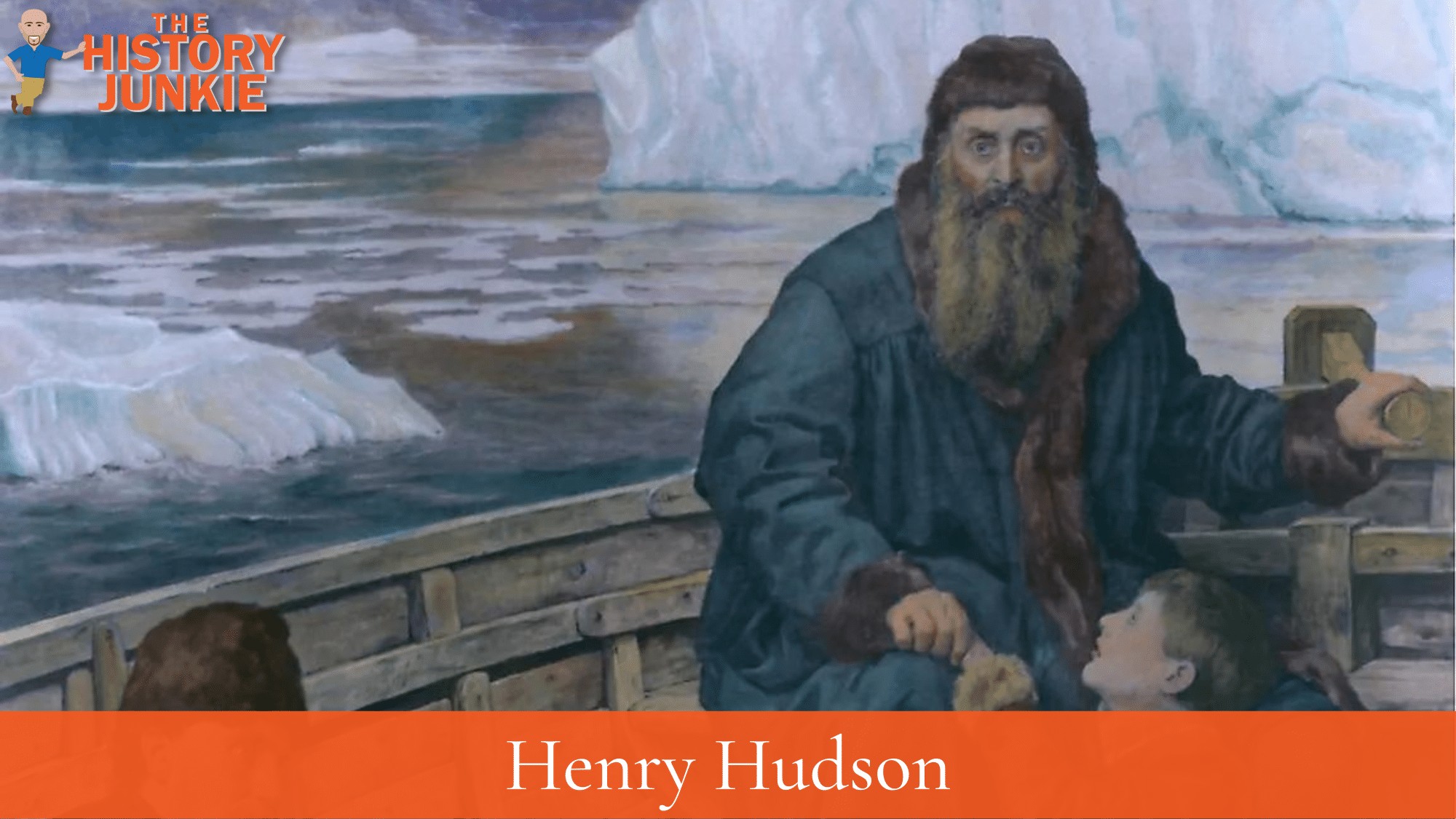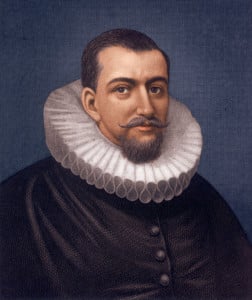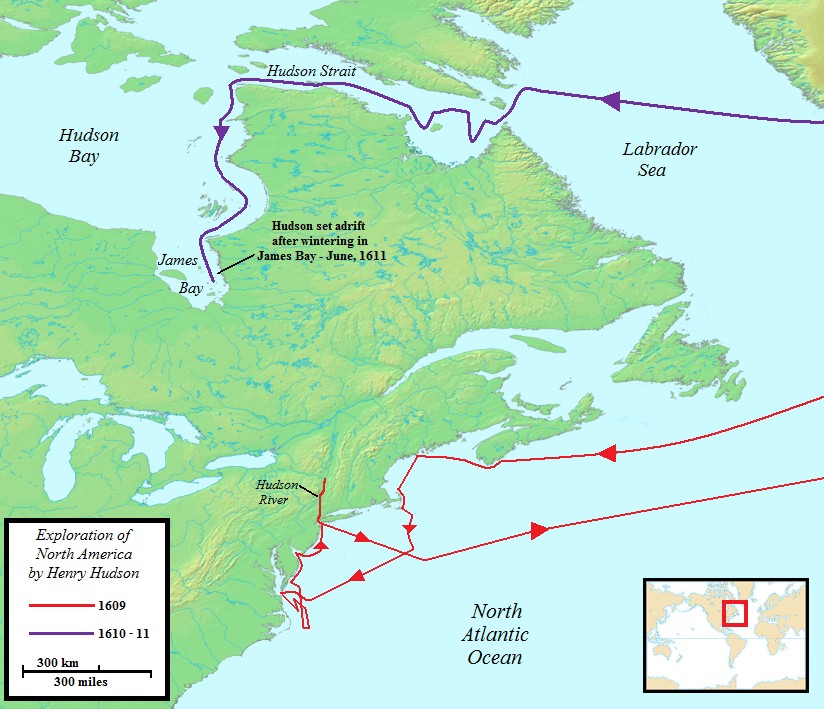Henry Hudson was a famous explorer who sailed for both England and the Dutch during the Age of Exploration. He explored modern New York City, Canada, and a large body of water that would be named after him, Hudson Bay.

He laid the foundation for Dutch colonization of the New World and may have been the first man to circumnavigate the globe by taking the northern passage, but his crew mutinied and abandoned him, his son, and those loyal to him in Canada.
They were never heard from again, although many legends survive.
Early Life and Family

There is some disagreement as to when Henry Hudson was born. The range of dates is from 1550 - to 1570s. There was a Henry Hudson in England who died in 1555, which suggests a possible father or grandfather. The 1550s date seems off since he would have been 60 by the time of his last voyage, which is unlikely.
He was from Hoddesdon, in Hertfordshire, about 17 miles northwest of London.
As a young man, he was most likely employed by the Moscavy Company. His family had shares in the company.
In 1587, he may have sailed for the Northwest Passage with explorer John Davis. During the voyage, Davis named what would later be called the Hudson Strait the Furious Overhaul.
Henry married Katherine and had three sons: Richard, John, and Oliver.
By all accounts, Katherine was an incredibly strong woman. After Henry and John failed to return from their voyage, she petitioned for rescue missions. Henry and John's death left her poor and destitute, but she managed to acquire much wealth through her own ingenuity and resourcefulness.
Henry's son Richard also accumulated much wealth in India. He was one of the first Europeans to be given a permit to live in Imperial Japan. He stayed in India for the rest of his life and lived a life of luxury. Several of his children migrated to the New World.
First Voyage
Hudson's first voyage took place in 1607. During this time, the English and the Dutch were competing for different trade routes and trying to find a northern passage to Asia.
His first command was of the Hopewell and was financed by the Muscovy Company. The vessel was old and had a small crew.
After some initial delays, Henry Hudson set sail with his crew on May 1, 1607.
By May 26, Hudson reached the Shetland Islands
On June 13, Hudson sighted the eastern coast of Greenland. Greenland is known for its rough weather and difficulty to navigate. Even today, these waters are considered treacherous to vessels - even today's modern steel-hulled ships with manganese-bronze propellers.
Sailing Directions, published by the U.S Defense Mapping Agency, notes the waters around southern Greenland as "Notorious for foul weather and heavy seas... Dangerous rocks up to four leagues... Very strong mountain squalls... Winds from the southeast very strong gale strength..."
Small, wooden ships like the Hopewell would have had to progress carefully, always watching for ice, rock, and sudden shifts in weather. A little inattention could quickly result in disaster.
Early-Mid June, the weather became treacherous. Hudson had been mapping the unexplored coast of Greenland and was forced to proceed without any visibility. This shows remarkable bravery and skill.
By June 20, the weather cleared, and Hudson steered away from Greenland.
There was little success in finding a northwest passage, although Hudson did discover a few islands and different wildlife.
Unfortunately, his discoveries led to the decimation of wildlife around many of those islands. The whale and walrus populations were destroyed by hunters wanting their tusks.
Hudson's first voyage ended on September 15, 1607. He still believed there to be a northwest passage and began to prepare for a second voyage.
Second Voyage
While making some discoveries in his first voyage, Hudson still believed there to be a shorter passage to the north that would take them to the wealthy Indies.
He took command of the Hopewell for a second time and again sailed for the Muscovy Company of England. This time, he would sail to the northeast around Russia, where he believed there would be a northeast passage.
On April 22, 1608, Hudson and his small crew set sail for the Northeast Passage.
On June 15, 1608, the crewmen sighted what they believed to be a mermaid. Hudson also described what they saw as a mermaid. He recorded what they saw in his log, saying that the creature had a tail like a porpoise, very white skin and was speckled, and had a woman's breast.
By June 27, Hudson reached an impasse. The waters were frozen, and he could not get through to the Kara Sea.
By July 5, Hudson decided that there was not a feasible northeast passage. He had explored many different rivers that proved to be too shallow, much of the arctic water remained frozen, and he had begun to fix his eyes on seeking the northwest passage. He secretly decided to set sail for the New World again.
The crew learned of Hudson's plan and forced his hand to return to England. They arrived in England on August 26, 1608.
Third Voyage

After Hudson's second failed attempt to find the Northwest Passage, he could not find a sponsor for his mission. He would eventually be approached by the Dutch East India Company and sail under a different flag.
The Dutch East India Company made Hudson sign a contract that required him to search for the Northeast passage, which he failed to find on his second voyage.
By May, he reached the coast of Nova Zemlya and saw nothing but ice and worse conditions than the year prior. He turned west towards the new world, and the crew began to mutiny.
Hudson was able to calm the crew by showing them maps from a good friend of his, Captain John Smith. John Smith is known for his contributions at Jamestown, but he also explored the coast of the New World and made maps. He had heard the natives talk of a northwest passage but had not been able to document it.
By July, the crew had dealt with much treacherous weather but reached the coast of Newfoundland.
The crew met and traded with many peaceful natives. Unfortunately, the natives put their trust in the wrong place because even though they showed much kindness and fed the crew well, the Europeans would pillage their village and rob them of their spoils.
Hudson explored the coast of New York and met many friendly native tribes. There were many instances where he and his crew traded for food, were invited to the local Indian village for dinner, and had drinks with the natives.
Hudson returned to the Old World after his crew threatened to mutiny. They sailed into Dartmouth, England, where Hudson was put under house arrest for sailing with the East India Company. It was not uncommon for mariners to sail under different flags, which suggests that Hudson was a victim of jealous merchants.
He and his crew never returned to Amsterdam
Fourth Voyage
Despite his arrest, Hudson was able to convince the Virginia Company to fund an exploration of the Northwest Passage.
Hudson and his crew left in mid-April and, by May 11, were passing Iceland.
Hudson was unable to navigate the Hudson Strait (which would be named later) due to ice and was forced to look for another passage.
By July, Hudson was trapped in Ungave Bay. He was forced to navigate slowly through the ice and deal with his mutinous crew, who began to want to go home. Hudson convinced them to press forward, and morale was boosted.
On August 2, 1610, Hudson came into what is now called Hudson Bay. He and his crew spoke of its beautiful waters and believed they had found the Northwest Passage.
He sailed along Hudson Bay and eventually James Bay, where he would eventually set up winter quarters.
Hudson's crew had shown signs of mutiny for months, and this did not change throughout the winter. His crew grew unhappier as time passed. By June of 1611, the crew wanted to head back to England, but Hudson wanted to press forward.
He continued to push his crew hard, and finally, they broke. They mutinied and left Hudson, his son John, and others behind.
Hudson and the others pursued in a small boat until the Discovery was out of sight.
Hudson and his remaining crew were never heard from again. He left behind many helpful resources for future mariners.
The Northwest Passage would not be successfully navigated until the Norwegian Explorer Roald Amundson explored it between 1903 - 1906.
Almost 300 years after Henry Hudson.
